Software helps drillers navigate hazards of engagement in CO2 reservoirs
By Jeremy Beckman, Editor-Europe
Operators and service companies are stepping up preparations for the second phase of drilling for carbon capture and storage. It’s at this point—infill drilling into reservoirs or aquifers already containing CO2 injected by the initial wells—that things might start to go wrong. In the worst cases, there could be toxic buildup of CO2 on the drill floor, corrosive damage to equipment on the rig or a blowout that may prove hard to contain.
Project Green Light, a pan-industry consortium led by Stavanger-based software engineers eDrilling, is addressing current gaps in well control technology. Last December, following completion of the project’s first laboratory testing phase, eDrilling issued the first commercial simulation software arising from the development, wellplannerCCUS. Further software releases will follow regularly over the next three years as Green Light progresses into Phase II.
According to eDrilling COO Sven-Inge Ødegård, the impetus for the development came early this decade, when Equinor and other operators began flagging well control for future CO2 infill wells as a risk.
“This was due to the industry’s knowledge gap when mixing drilling fluids with CO2 during a well control situation,” he said.
Equinor was onboard when Green Light started in 2022, joined shortly afterward by Transocean. Over the next two years, three other operators, Shell, Eni and CNOOC, joined the consortium, along with Baker Hughes, Noble Corp., Wild Well Control and EBN.
Norwegian research organization SINTEF is the R&D partner, conducting the project’s laboratory experiments in Trondheim, Norway, using drilling fluids supplied by Baker Hughes, mixed with CO2, also providing multiphase modeling support. Wild Well Control has contributed relevant know-how and experience dealing with well control incidents. Gassnova CLIMIT, as funding partner, represents the Norwegian state’s interests in CO2 capture, transport and storage.
As far as Ødegård is aware, “this is the only initiative where research (data from experiments) is deployed in multi-phase dynamic models and released as Open API software in addition to traditional 'Windows’ software."
He added, "Our team consists of a mix of highly experienced software developers with well control knowledge and research (PhDs) performing laboratory experiments and multi-phase dynamic model development. Experts from the partners have been engaged to fully understand the market challenges and needs, and guide eDrilling through development of a commercial software product for CO2 well control."
The primary stated goals of the consortium are to develop services and software tools for safe drilling of CO2 wells in CO2 infill regions, specifically:
- Qualified software for well control in CO2 wells for use in planning and risk assessment prior to drilling, and for detecting anomalies once drilling has started; and
- A methodology for assessing the suitability of drilling fluids related to CO2 well construction in infill regions.
Secondary aims are to:
- Determine experimentally the impact of CO2 on drilling fluid properties (i.e., rheology, phase envelope and cooling impact during pressure drop); and
- Describe mathematically the resulting rheology and thermodynamics for implementation in the well control software developed by eDrilling.
Phase I conclusions
As described in a recent report on CO2 blowout considerations prepared by Wild Well Control for the Norwegian Ocean Industry Authority (Havtil), the Phase I laboratory experiments conducted by Sintef between September 2023 and June 2024 focused on a mix of CO2 with three commercial drilling fluids: one oil-based and two water-based. A primary goal was to evaluate how much CO2 could be dissolved physically in drilling fluids and how this affects the fluid properties.
“Some surprises were identified during this program,” Ødegård said.
The main conclusions about CO2’s behavior mixed with drilling fluids were as follows:
- Solubility: CO2 solubility increases with pressure but decreases with temperature. CO2 has higher solubility in oil-based drilling fluids (OBDF) than in water-based drilling fluids (WBDF), and factory-fresh fluids can behave differently from those used in the field.
- Density: Adding CO2 reduces the density of OBDF but has only a minor effect on WBDF, except at high temperatures.
- Viscosity: CO2 makes OBDF much thinner and WBDF slightly thinner.
- Hydrate formation: CO2 hydrates are observed to form in WBDFs but not in the OBDF studied.
- Robustness: CO2 will change the properties of some drilling fluids under certain conditions, making them less viscous and causing them to separate into different phases.
Among the deliverables highlighted in Wild Well Control’s summary of the Phase 1 campaign was the development of an integrated model. This was combined with the experimental measurements to describe a three-phase equilibrium: a brine phase with dissolved CO2, an oil phase with dissolved CO2 and a pure vapor CO2 phase. eDrilling implemented this model into the initial software. Some of the Green Light partners used this software to set up and test wells with CO2, investigating different configurations and CO2 influx scenarios.
Following completion of the Beta software testing phase late last year, eDrilling issued the first version of the WellControl CCUS module, wellplannerCCUS, with a full commercial launch set to follow this spring. The initial version, Wild Well Control noted, is limited to a single well, allowing users to simulate an influx and primary response strategy. The next planned development is a relief well dynamic kill module, enabling simulation of two interconnected wells, “such as a relief well intersecting and killing in the well control software," Ødegård added.
How it works
According to eDrilling, the wellplannerCCUS module allows the user to simulate drilling into zones containing CO2 and study the impact on pressure and temperature when CO2 starts to commingle with drilling fluid (both oil and water-based), causing a well control situation. At that point, the software takes into account observations and findings from laboratory tests concerning solubility, bubble point, phase distribution, rheology and Joule-Thompson effects.
The software has been tested on actual CO2 wells with data supplied by the project partners. So users can simulate different scenarios to manage the risk of a potential blowout when drilling into areas containing CO2.
The software contains four simulation modules:
- An optimization module running a series of scenarios to allow users to determine the best drilling and tripping parameters for their operation;
- A dynamic hydraulics and temperature module, including dynamic temperature modeling, pressure analysis and cuttings management;
- A torque and drag module, simulating string forces and string torque that are essential for monitoring and diagnosis of a drilling process; and
- A well control module for a kick or influx of CO2 or methane.
Some of the partners have signed license agreements for wellPlannerCCUS, and all have pledged continued support for Phase II. Further supermajors, majors and service companies are considering joining, Ødegård added.
“This new phase will cover the knowledge gaps identified during Phase I," he said. "The main focus will be kinetics (how quickly CO2 will boil out of drilling fluids) and formation of hydrates, which will be a major risk for equipment, people and the environment. All these activities will be carried out with the same workflow (experimental tests using local models, an integrated multiphase model and a software product). Some of the tasks require extensive and time-consuming laboratory experiments; that is why this is a three-year project."
He continued, “Contaminations of CO2 have also been raised as an area of interest for Phase II. It is unclear how different impurities that are typical for captured CO2, such as NOx and SOx, or hydrocarbons from the underground, will impact the behavior of a CO2 kick.”
Although the first wells into CO2-filled reservoirs are still a couple of years away, “the industry needs to have full simulation capabilities ready now to evaluate the risk before drilling,” Ødegård stressed.
Are the Green Light partners confident that, based on all results to date, they can collectively manage/understand any well control/drilling issues that may arise during these campaigns? “If you ask us, yes,” he concluded.
Want more drilling content?
Offshore's monthly Drilling Technology Report e-newsletter provides updates on the latest drilling equipment, techniques, challenges and technologies. Subscribe (it's FREE) to receive the latest offshore drilling news and insights from the oil and gas industry.
About the Author
Jeremy Beckman
Editor, Europe
Jeremy Beckman has been Editor Europe, Offshore since 1992. Prior to joining Offshore he was a freelance journalist for eight years, working for a variety of electronics, computing and scientific journals in the UK. He regularly writes news columns on trends and events both in the NW Europe offshore region and globally. He also writes features on developments and technology in exploration and production.


